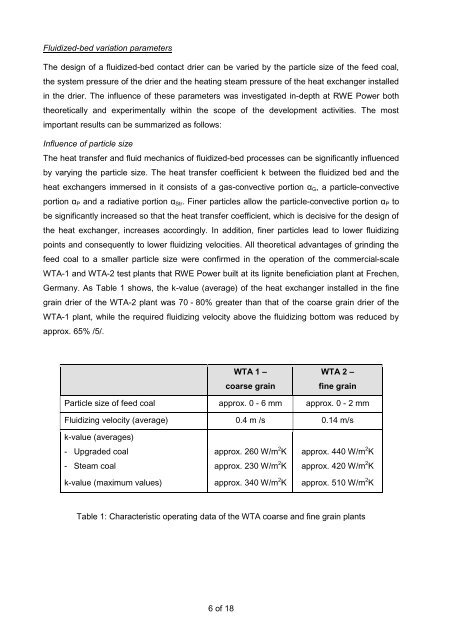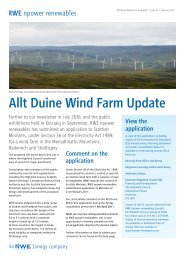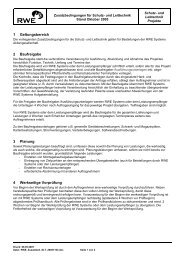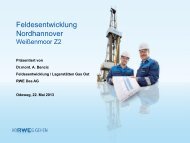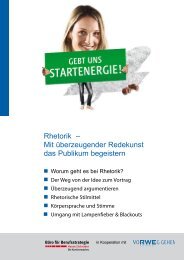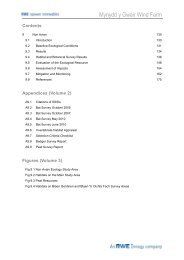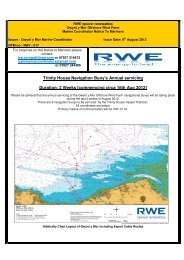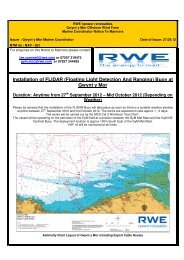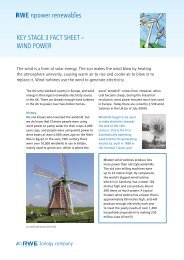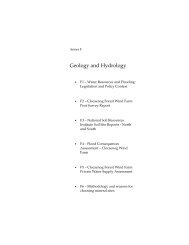Development status of WTA fluidized-bed drying for - RWE.com
Development status of WTA fluidized-bed drying for - RWE.com
Development status of WTA fluidized-bed drying for - RWE.com
Create successful ePaper yourself
Turn your PDF publications into a flip-book with our unique Google optimized e-Paper software.
Fluidized-<strong>bed</strong> variation parameters<br />
The design <strong>of</strong> a <strong>fluidized</strong>-<strong>bed</strong> contact drier can be varied by the particle size <strong>of</strong> the feed coal,<br />
the system pressure <strong>of</strong> the drier and the heating steam pressure <strong>of</strong> the heat exchanger installed<br />
in the drier. The influence <strong>of</strong> these parameters was investigated in-depth at <strong>RWE</strong> Power both<br />
theoretically and experimentally within the scope <strong>of</strong> the development activities. The most<br />
important results can be summarized as follows:<br />
Influence <strong>of</strong> particle size<br />
The heat transfer and fluid mechanics <strong>of</strong> <strong>fluidized</strong>-<strong>bed</strong> processes can be significantly influenced<br />
by varying the particle size. The heat transfer coefficient k between the <strong>fluidized</strong> <strong>bed</strong> and the<br />
heat exchangers immersed in it consists <strong>of</strong> a gas-convective portion αG, a particle-convective<br />
portion αP and a radiative portion αStr. Finer particles allow the particle-convective portion αP to<br />
be significantly increased so that the heat transfer coefficient, which is decisive <strong>for</strong> the design <strong>of</strong><br />
the heat exchanger, increases accordingly. In addition, finer particles lead to lower fluidizing<br />
points and consequently to lower fluidizing velocities. All theoretical advantages <strong>of</strong> grinding the<br />
feed coal to a smaller particle size were confirmed in the operation <strong>of</strong> the <strong>com</strong>mercial-scale<br />
<strong>WTA</strong>-1 and <strong>WTA</strong>-2 test plants that <strong>RWE</strong> Power built at its lignite beneficiation plant at Frechen,<br />
Germany. As Table 1 shows, the k-value (average) <strong>of</strong> the heat exchanger installed in the fine<br />
grain drier <strong>of</strong> the <strong>WTA</strong>-2 plant was 70 - 80% greater than that <strong>of</strong> the coarse grain drier <strong>of</strong> the<br />
<strong>WTA</strong>-1 plant, while the required fluidizing velocity above the fluidizing bottom was reduced by<br />
approx. 65% /5/.<br />
6 <strong>of</strong> 18<br />
<strong>WTA</strong> 1 –<br />
coarse grain<br />
<strong>WTA</strong> 2 –<br />
fine grain<br />
Particle size <strong>of</strong> feed coal approx. 0 - 6 mm approx. 0 - 2 mm<br />
Fluidizing velocity (average) 0.4 m /s 0.14 m/s<br />
k-value (averages)<br />
- Upgraded coal<br />
- Steam coal<br />
k-value (maximum values)<br />
approx. 260 W/m 2 K<br />
approx. 230 W/m 2 K<br />
approx. 340 W/m 2 K<br />
approx. 440 W/m 2 K<br />
approx. 420 W/m 2 K<br />
approx. 510 W/m 2 K<br />
Table 1: Characteristic operating data <strong>of</strong> the <strong>WTA</strong> coarse and fine grain plants


